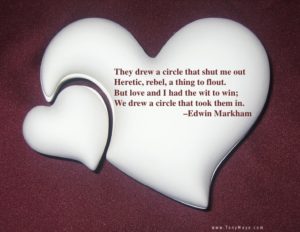I’ve come to the understanding that “enemy” is a social construct. I think humans are born with a need for community, for connection and our first instincts are to welcome and trust all with whom we come into contact. There is no “other” when we begin this journey; we all are human.
But somewhere in the process of clarifying that age-old “who is my neighbor” question, we think we need to decide who is in our circle and who is not. Tribal tendencies demand specification: we want to know exactly where we stand in the various social hierarchies we invent for ourselves.
Of course there is another definition for the word “enemy” and we humans quickly learn not to trust those who do harm. But the act of doing harm to another begins in the mind; there is a cognitive shift in basic understandings about what it means to be human. Someone who acts as an enemy to another has already placed them outside their circle and named them as “other.” They justify their actions based on contrived categories of who is in and who is out. Then the one who has been hurt responds to that mistreatment by doing the same thing: if we have been damaged by X or Y or Z, then everyone who is like them must also be our enemy.
It is a vicious cycle. Not at all neat or logical. We humans can be a complex mess.
 Nelson Mandela was honored recently at a 100th birth day celebration in South Africa. Here is someone who taught himself how to break free of the vicious cycle and his life still serves as an example to all of us want to learn a better way.
Nelson Mandela was honored recently at a 100th birth day celebration in South Africa. Here is someone who taught himself how to break free of the vicious cycle and his life still serves as an example to all of us want to learn a better way.
President Obama spoke at the event in Johannesburg and reminded us what a whole and wholesome human looks like.
Mandela lived with complexity.
In prison, he studied Afrikaans so that he could better understand the people who were jailing him. And when he got out of prison, he extended a hand to those who had jailed him, because he knew that they had to be a part of the democratic South Africa that he wanted to build.
“To make peace with an enemy,” he wrote, “one must work with that enemy, and that enemy becomes one’s partner.”
Nelson Mandela’s work for reconciliation was genius.
South Africa’s Truth and Reconciliation Commission shepherded more than 20,000 people through a process of naming the truth about some of the acts of violence perpetrated during apartheid and then forgiving those “enemies.” This is difficult, painful work but it is the only way to move from enemy to neighbor.
Forgiveness (in order to be authentic and healing) must include the acknowledgment of the damage done. Here is the “truth” part. We name the violence, we name the pain; we don’t excuse it or diminish it. Only then can we move on and let the pain go so that we are not shackled to its crippling power any longer.
Only then can we transform an enemy into a partner. Only then can we recreate a community of neighbors.
In the New Testament, Jesus told a parable about what it means to be “neighbor.” It started with a lawyer asking “who is my neighbor” but Jesus turned the question by asking: “who is the neighbor?”
Who in the famous story of the Good Samaritan showed mercy? Who was the one who acted like the neighbor?
Our world desperately needs more neighbors and fewer enemies. If we are to reclaim our humanity – the best of what it means to be human – then some of us must step up and grow up and reach out to our “enemies” with mercy, courage and compassion.
More of us need to redraw the circles of our community to include “others.”  Other colors, other languages, other religions, other customs, other socioeconomic classes, other politics … It’s high time the grown ups start deconstructing our old social constructs and begin to create a new world for our children.
Other colors, other languages, other religions, other customs, other socioeconomic classes, other politics … It’s high time the grown ups start deconstructing our old social constructs and begin to create a new world for our children.
Here. This is our challenge.
Who will be the neighbor?
Read President Obama’s 2018 speech here.
Watch it here. (1 hour 24 minutes)
To speak truth, I live in a neighborhood of working /poor immigrants and people are afraid to come to my neighborhood. In the 15 yrs living here we had one break in and the person who did it came back and apologized returned what he took…my husband and I have gotten to know him and helped this young man. He was my enemy he violated my home and took things from me, but life isn’t what is on the surface. One person at a time, one house before you know it the neighbors are more your brothers and sisters. But it has to start with ONE person
Excellent article, I fully support the idea. It all starts in our neighborhood, then the church, then the community and so on. One first step is to get our Pastor’s teaching that lesson.
Yes Terry. We must begin building bridges with our own neighbors. The breakdown of our communities has damaged all of us in some deep ways. Let’s get going on our repairs! Thanks for reading and thanks for the conversation. Peace.